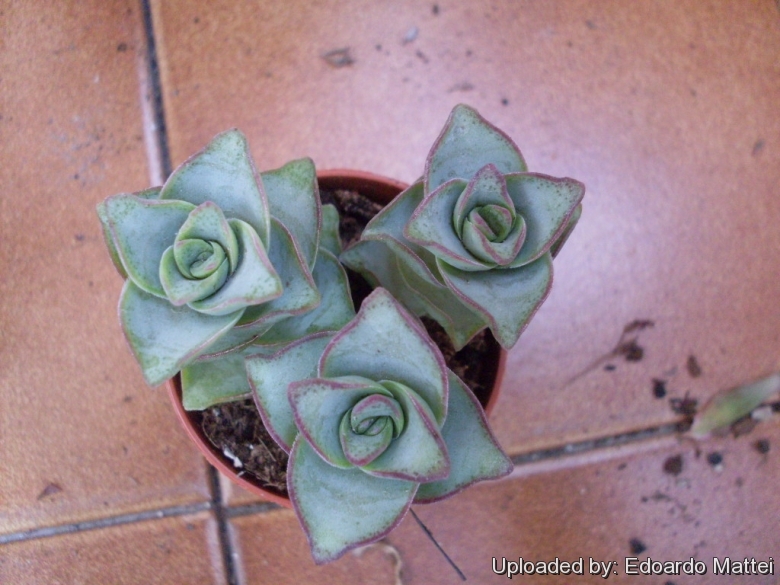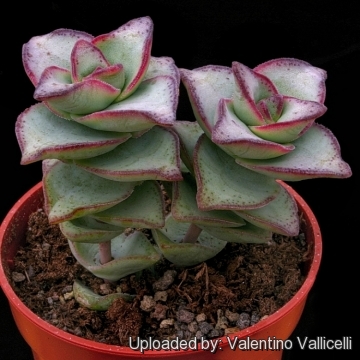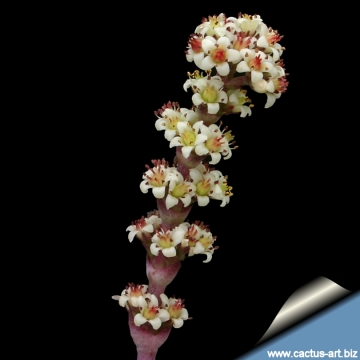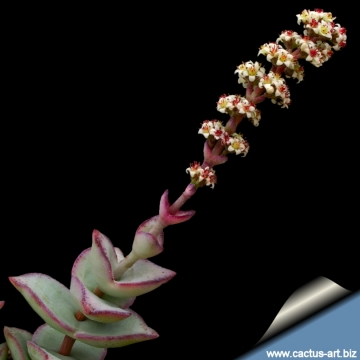Accepted Scientific Name: Crassula perforata Thunb.
Nova Acta Phys.-Med. Acad. Caes. Leop.-Carol. Nat. Cur. 6: 319 1778

Crassula perfossa Photo by: Edoardo Mattei
Origin and Habitat: South Africa.
Synonyms:
See all synonyms of Crassula perforata
back
Accepted name in llifle Database:Crassula perforata Thunb.Nova Acta Phys.-Med. Acad. Caes. Leop.-Carol. Nat. Cur. 6: 319 1778Synonymy: 11
Accepted name in llifle Database:Crassula perforata subs. kougaensis van Jaarsv. & A.E.van WykAloe 46(1): 22 (-23; figs., map). 2009
back
Common Names include:
ENGLISH: Necklace Vine, String of Buttons
Description: The 'String of Buttons' or 'Necklace Vine' (Crassula perfossa) is a small and compact matforming succulent shrublet that stays relatively low and clumps readily.
Stem: Up to about 15 tall, erect, fleshy, later prostrate and woody.
Leaves: In pairs, Fused so that they appear to be like beads on a string. They are broadly ovate, keeled with short-pointed tip, at right angles to the stem, 1.5 to 2 cm. long , 9 to 13 mm wide and more or less velvety. Gray-green (covered with a light pruinose surface. These characters preserve moisture and protect from strong sunlight) with small whitish or pink dots on the margin.
Flowers: Produces an elongate cyme, of very small, white sweet-scented flowers.
Blooming season: Flowers appear in every time of the year when conditions are appropriate, but they tend to be produced mainly during winter or early spring.
Remarks: In country homes one will find flower pots with the long, hanging branches on shelves or between windows. In the past years these plants have been gaining in popularity and a large number of hybrid and cultivars has been grown. There is also a nice cultivar with yellow-cream variegation which fades as the older foliage matures.
Subspecies, varieties, forms and cultivars of plants belonging to the Crassula perforata group
Bibliography: Major references and further lectures
1) Doreen Court "Succulent Flora of Southern Africa" CRC Press, 01/giu/2000
2) James Cullen, Sabina G. Knees, H. Suzanne Cubey "The European Garden Flora Flowering Plants: A Manual for the Identification of Plants Cultivated in Europe, Both Out-of-Doors and Under Glass" Cambridge University Press, 11/ago/2011
3) Hermann Jacobsen ”A Handbook of Succulent Plants: Abromeitiella to Euphorbia” Blandford Press, 1960
4) Hermann Jacobsen “A handbook of succulent plants: descriptions, synonyms, and cultural details for succulents other than Cactaceae” Volume 1 Blandford Press, 1960
5) Dr J.P. Roux “Flora of South Africa." 2003
 - Easy to flower and easy to grow, it is a favourite of many hobbyists. Produces pairs of attractive and interesting grey leaves. This dwarf Crassula is an attractive plant that can be easily housed in a small place. Photo by: Valentino Vallicelli
- Easy to flower and easy to grow, it is a favourite of many hobbyists. Produces pairs of attractive and interesting grey leaves. This dwarf Crassula is an attractive plant that can be easily housed in a small place. Photo by: Valentino Vallicelli Crassula perfossa Photo by: Cactus Art
Crassula perfossa Photo by: Cactus Art The flowers are very tiny and give the impression that don’t open, but it is only an impression. Photo by: Cactus Art
The flowers are very tiny and give the impression that don’t open, but it is only an impression. Photo by: Cactus ArtSend a photo of this plant.The gallery now contains thousands of pictures, however it is possible to do even more. We are, of course, seeking photos of species not yet shown in the gallery but not only that, we are also looking for better pictures than those already present.
Read More... Cultivation and Propagation: Crassula perfossa is a an easy to care popular succulent grown also as a suspended plant. It does well in light homes between the windows too.
Soil: They will require a free draining and rich compost.
Waterings: They need adequate watering during the growing period and only light application of water in winter so that the leaves do not shrivel unduly. Fairly drought tolerant elsewhere.
Exposure: Requires good light to keep the plants compact and encourage leaf colour and flowering. The pruinose stem coatings of the plants in our collection sometime is not so intense as those of the plants in their natural habitat but the difference in coating is thought due to the higher humidity and less intense sunlight of our climate.
*Maintenance: After growing for some time the stems tend to become untidy and pendulous and should be cut very short or restarted from cuttings.
Pests and diseases: Crassulas are sensitive to mealybugs.
Hardiness: The best temperature is 7 to 10 °C (but hardy to -5° C for short periods)
Propagation: It is propagated with ease from the short shoots which are potted into rich, porous soil where they quickly take root.













